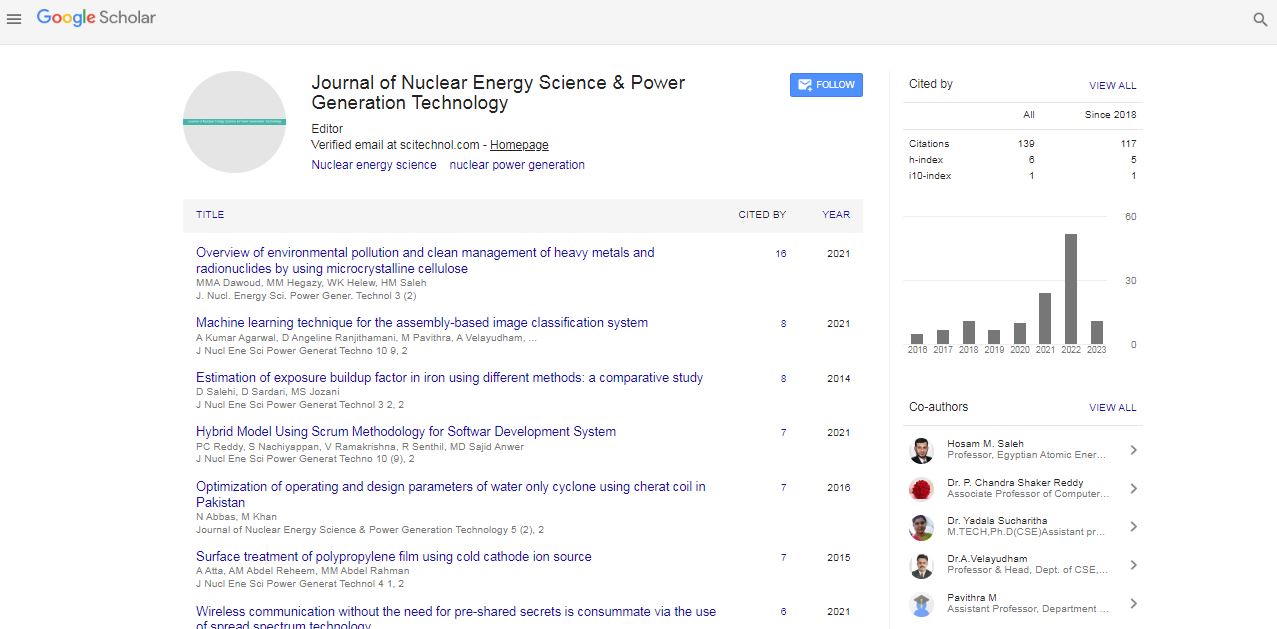Opinion Article, J Nucl Ene Sci Power Generat Technol Vol: 13 Issue: 1
Utilization of Earth's Heat and Exploring the Potential of Geothermal Energy
Pardai Saphie*
1Department of Geological Engineering, Institut Teknologi Bandung, Jawa Barat, Indonesia
*Corresponding Author: Pardai Saphie,
Department of Geological Engineering,
Institut Teknologi Bandung, Jawa Barat, Indonesia
E-mail: pardai_saphie289@gmail.com
Received date: 23 December, 2023, Manuscript No. JNPGT-24-130441;
Editor assigned date: 26 December, 2023, PreQC No. JNPGT-24-130441 (PQ);
Reviewed date: 09 January, 2024, QC No. JNPGT-24-130441;
Revised date: 16 January, 2024, Manuscript No. JNPGT-24-130441 (R);
Published date: 23 January, 2024, DOI: 10.4172/2325-9809.1000377.
Citation: Saphie P (2024) Utilization of Earth's Heat and Exploring the Potential of Geothermal Energy. J Nucl Ene Sci Power Generat Technol 13:1.
Description
Geothermal energy, derived from the Earth's internal heat, presents an abundant and renewable resource with the potential to revolutionize our energy landscape. Unlike fossil fuels, which are finite and environmentally harmful, geothermal energy provides a sustainable solution to meet our growing energy demands while reducing greenhouse gas emissions. By binding into the Earth's heat, can generate electricity, heat buildings, and even facilitate industrial processes, all with minimal environmental impact. The Earth's heat originates from its core, where temperatures reach several thousand degrees Celsius due to radioactive decay and residual heat from planetary formation. This heat gradually moves towards the surface through conduction and convection, creating thermal gradients in the Earth's crust. In regions where these gradients are significant, such as near tectonic plate boundaries or volcanic hotspots, geothermal energy becomes accessible through various technologies.
Types of geothermal systems
Geothermal energy extraction primarily relies on two types of systems: direct-use systems and geothermal power plants.
Direct-use systems: These systems utilize hot water from shallow wells or springs for heating buildings, greenhouse cultivation, or recreational purposes such as hot springs spas. Direct-use applications are straightforward and require minimal technology, making them accessible for small-scale deployments.
Geothermal power plants: These plants harness the Earth's heat to generate electricity. The most common approach involves drilling deep wells to access high-temperature reservoirs, where water or steam is present. This pressurized fluid is then brought to the surface to drive turbines connected to generators, producing electricity. Geothermal power plants can be further categorized into three types: dry steam, flash steam, and binary cycle plants, depending on the state of the fluid extracted.
Advantages of geothermal energy
Geothermal energy provides several advantages over conventional fossil fuels and other renewable energy sources. Unlike solar and wind energy, which are intermittent, geothermal energy provides a consistent base-load power, ensuring reliable electricity generation regardless of weather conditions. Geothermal power plants produce minimal greenhouse gas emissions and have a small land footprint compared to fossil fuel plants. Additionally, they consume relatively little water, especially in closed-loop binary cycle systems. Geothermal reservoirs can sustain energy production for decades to centuries with proper management, providing long-term energy security and economic stability. Geothermal resources are distributed worldwide, allowing for decentralized energy production and reducing dependence on centralized power grids.
Conclusion
Despite its numerous benefits, the widespread adoption of geothermal energy faces several challenges. The upfront costs of drilling and reservoir exploration can be substantial, particularly for deep geothermal projects. Not all regions have suitable geothermal reservoirs close to the surface, limiting the geographic availability of geothermal energy. Extracting heat from deep reservoirs requires advanced drilling techniques and engineering expertise, increasing the complexity and risk of geothermal projects. However, ongoing research and technological advancements provide solution to overcome these challenges. Enhanced Geothermal Systems (EGS) aim to expand the reach of geothermal energy by creating artificial reservoirs through hydraulic fracturing and reservoir stimulation techniques. Innovations in drilling technology, such as slim-hole drilling and directional drilling, can reduce costs and improve the efficiency of geothermal exploration and production. Geothermal energy represents a valuable and underutilized resource in our transition towards a sustainable energy future. By harnessing the Earth's heat, can reduce our reliance on fossil fuels, mitigate climate change, and promote energy independence. With continued investment in research, development, and infrastructure, geothermal energy has the potential to play a significant role in powering the world for generations to come.
 Spanish
Spanish  Chinese
Chinese  Russian
Russian  German
German  French
French  Japanese
Japanese  Portuguese
Portuguese  Hindi
Hindi 

